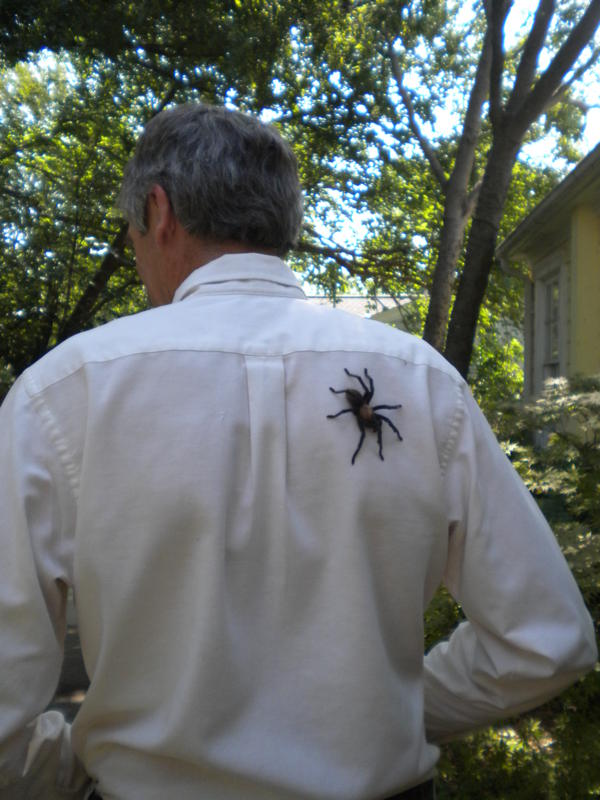This has been tarantula week in Dallas. I don’t get too many tarantula calls as a rule; tarantulas are nocturnal homebodies, rarely venturing more than a foot from their burrow…except during mating season. For a short time in the spring (and to some extent in the fall), usually after a rain, male Texas brown tarantulas (Aphonopelma hentzi complex) leave their burrows and hidey-holes in search of–what else?–romance. In some parts of the state dozens of spiders may be seen at once, especially at night along lonely west Texas highways.
According to Burr Williams of the Sibley Nature Center in Midland, who has observed tarantula courtship in west Texas, once a male catches a female’s pheromone scent, they seem very good at orienting to a female’s burrow. The male taps at the entrance and the female lunges out. The male grabs her, mates quickly, and it’s over–sometimes permanently for the male.
Most authorities (e.g., Thomas Prentiss in Ubick et. al, Spiders of North America) say that mature male tarantulas don’t live long. Whether this is because they usually get eaten, or just don’t have what it takes to be a long-liver (females have been observed to live 30 years in captivity), I’m not sure. But the male spider I placed yesterday in a terrarium with my 7-year-old female Texas brown Tarantula certainly didn’t last long. This morning a leg and a few unidentifiable scraps of carapace were all that was left. I can only hope he enjoyed his final moments.
According to a 1999 study by Margaret Janowski-Bell and Norman Horner, who glued antennae to the backs of the tarantulas and followed them around the wild (how cool is that!) males in the wild may visit multiple females, and thus must have a better chance of escape from the than my unlucky captive.
Most of the folks who called about tarantulas this week seemed worried. One gentleman was worried that his child would be bitten. Another was ready to sell his house and move (presumably as far away from Texas as possible) after finding his backyard and and exterior walls of his home hosting multiple tarantulas.
Fortunately, tarantulas are not that dangerous. Forget Spielberg’s Arachnophobia if you can, a tarantula is a shy giant of a spider. The venom is not considered especially toxic, on the order of a bee sting. But the chance of being bitten by a tarantula is slim. Add to that the fact that tarantulas, like all spiders, do much good by controlling the general insect population.

A tarantula mysteriously ended up on Dr. Knutson's shirt recently, while he was gardening in his backyard.
Having said this, I am likely to undo all my “spider good will” by sharing a recent adventure of my friend and colleague, Dr. Allen Knutson. Allen lives in an older neighborhood of McKinney, Texas. He and his wife notice tarantulas from time to time on walks in their neighborhood. Nevertheless it was a shock for wife when Allen walked into the kitchen after working in the garden recently with a hitchhiking tarantula. Thinking she was making a lot of fuss over a little spider, even entomologist Allen was surprized to find a 4-inch male tarantula clinging to his back. After being quickly shooshed out of the kitchen, Allen was brave enough to stand for the accompanying picture. Allen noted matter-of-factly that the spider looked much bigger in real life than it does in the picture. I’m sure.
So what should you do if you find tarantulas in your backyard? I know this will be a hard pill for some to swallow, but consider yourself lucky! Tarantulas are a sign that things are as they should be. They represent a healthy ecosystem where pests must fight for their miserable lives. And they’re a sign of Texas.
After all, what would Texas be without its prickly pears, tarantulas, scorpions, rattlesnakes and brown recluses? I know one thing for sure. It wouldn’t be Texas.
